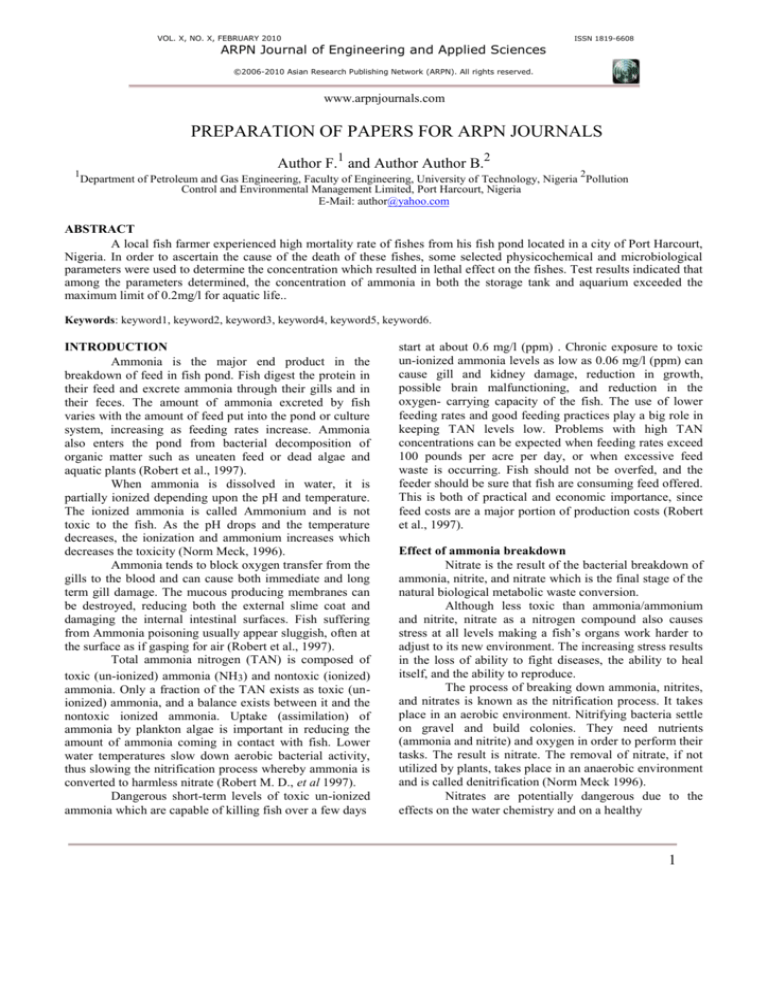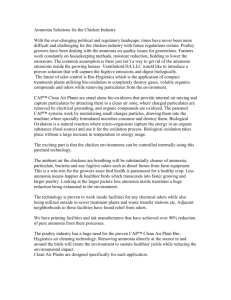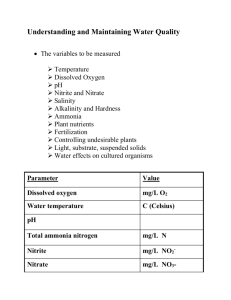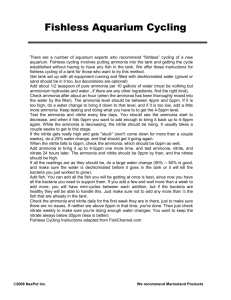
VOL. X, NO. X, FEBRUARY 2010
ISSN 1819-6608
ARPN Journal of Engineering and Applied Sciences
©2006-2010 Asian Research Publishing Network (ARPN). All rights reserved.
www.arpnjournals.com
PREPARATION OF PAPERS FOR ARPN JOURNALS
1
Author F.1 and Author Author B.2
2
Department of Petroleum and Gas Engineering, Faculty of Engineering, University of Technology, Nigeria Pollution
Control and Environmental Management Limited, Port Harcourt, Nigeria
E-Mail: author@yahoo.com
ABSTRACT
A local fish farmer experienced high mortality rate of fishes from his fish pond located in a city of Port Harcourt,
Nigeria. In order to ascertain the cause of the death of these fishes, some selected physicochemical and microbiological
parameters were used to determine the concentration which resulted in lethal effect on the fishes. Test results indicated that
among the parameters determined, the concentration of ammonia in both the storage tank and aquarium exceeded the
maximum limit of 0.2mg/l for aquatic life..
Keywords: keyword1, keyword2, keyword3, keyword4, keyword5, keyword6.
INTRODUCTION
Ammonia is the major end product in the
breakdown of feed in fish pond. Fish digest the protein in
their feed and excrete ammonia through their gills and in
their feces. The amount of ammonia excreted by fish
varies with the amount of feed put into the pond or culture
system, increasing as feeding rates increase. Ammonia
also enters the pond from bacterial decomposition of
organic matter such as uneaten feed or dead algae and
aquatic plants (Robert et al., 1997).
When ammonia is dissolved in water, it is
partially ionized depending upon the pH and temperature.
The ionized ammonia is called Ammonium and is not
toxic to the fish. As the pH drops and the temperature
decreases, the ionization and ammonium increases which
decreases the toxicity (Norm Meck, 1996).
Ammonia tends to block oxygen transfer from the
gills to the blood and can cause both immediate and long
term gill damage. The mucous producing membranes can
be destroyed, reducing both the external slime coat and
damaging the internal intestinal surfaces. Fish suffering
from Ammonia poisoning usually appear sluggish, often at
the surface as if gasping for air (Robert et al., 1997).
Total ammonia nitrogen (TAN) is composed of
toxic (un-ionized) ammonia (NH3) and nontoxic (ionized)
ammonia. Only a fraction of the TAN exists as toxic (unionized) ammonia, and a balance exists between it and the
nontoxic ionized ammonia. Uptake (assimilation) of
ammonia by plankton algae is important in reducing the
amount of ammonia coming in contact with fish. Lower
water temperatures slow down aerobic bacterial activity,
thus slowing the nitrification process whereby ammonia is
converted to harmless nitrate (Robert M. D., et al 1997).
Dangerous short-term levels of toxic un-ionized
ammonia which are capable of killing fish over a few days
start at about 0.6 mg/l (ppm) . Chronic exposure to toxic
un-ionized ammonia levels as low as 0.06 mg/l (ppm) can
cause gill and kidney damage, reduction in growth,
possible brain malfunctioning, and reduction in the
oxygen- carrying capacity of the fish. The use of lower
feeding rates and good feeding practices play a big role in
keeping TAN levels low. Problems with high TAN
concentrations can be expected when feeding rates exceed
100 pounds per acre per day, or when excessive feed
waste is occurring. Fish should not be overfed, and the
feeder should be sure that fish are consuming feed offered.
This is both of practical and economic importance, since
feed costs are a major portion of production costs (Robert
et al., 1997).
Effect of ammonia breakdown
Nitrate is the result of the bacterial breakdown of
ammonia, nitrite, and nitrate which is the final stage of the
natural biological metabolic waste conversion.
Although less toxic than ammonia/ammonium
and nitrite, nitrate as a nitrogen compound also causes
stress at all levels making a fish’s organs work harder to
adjust to its new environment. The increasing stress results
in the loss of ability to fight diseases, the ability to heal
itself, and the ability to reproduce.
The process of breaking down ammonia, nitrites,
and nitrates is known as the nitrification process. It takes
place in an aerobic environment. Nitrifying bacteria settle
on gravel and build colonies. They need nutrients
(ammonia and nitrite) and oxygen in order to perform their
tasks. The result is nitrate. The removal of nitrate, if not
utilized by plants, takes place in an anaerobic environment
and is called denitrification (Norm Meck 1996).
Nitrates are potentially dangerous due to the
effects on the water chemistry and on a healthy
1
VOL. X, NO. X, FEBRUARY 2010
ISSN 1819-6608
ARPN Journal of Engineering and Applied Sciences
©2006-2010 Asian Research Publishing Network (ARPN). All rights reserved.
www.arpnjournals.com
environment for fish while nitrates are accumulating. The
higher the nitrate levels the higher and severe the
consequences due to the stress on fish and the favorable
conditions for a serious algae outbreak.
Nature provides an almost nitrate free
environment with levels around 5ppm or less. The higher
the nitrate concentration the more stress for the fish.
Extremely severe stress is reached at levels exceeding
60ppm. Most of the plants fail before reaching this level.
This is due to an accumulation of live forms feeding from
the waste and the consequently higher biomass (animals
living in the aquarium) leads to an increasing demand of
oxygen (Norm Meck, 1996).
Therefore nitrate levels (NO3) should be kept
below 10ppm. Nitrate is also a key nutrient source for
algae. Most of the pesky and unwanted algae thrive on
poor water quality (Damon, T. A., 1999), high nutrient
levels and excessive nitrate. Many initially cycling tanks
experience an algae bloom due to this effect.
If the food is offered when too cold then the food
will remain uneaten in the pond, begin to breakdown and
pollute the water, leading to water quality problems,
ultimately
stressing
the
fish
(www.ponddoctor.co.uk/longgoldfishcarefeeding.htm).
Almost all of the oxygen dissolved into the water
from an air bubble occurs when the bubble is being
formed. Only a negligible amount occurs during the
bubbles transit to the surface of the water. This is why an
aeration process that makes many small bubbles is better
than one that makes fewer larger ones. The breaking up of
larger bubbles into smaller ones also repeats this
formation and transfer process..
PHYSICO-CHEMICAL ANALYSIS
pH, Temperature, conductivity, TDS and
dissolved oxygen
These chemical properties were determined
electrometrically with a multi- parameter data logger
(Hanna model HI991300).
Chloride and salinity as chloride
These were determined titrimetrically in
accordance with APHA 2520A. About 25ml of the sample
was measured in a beaker and a drop of potassium
chromate indicator added. The solution was titrated with
AgNO3 solution until the appearance of brick red colour
as the end point.
Calculations: Cl- (mg/l) = Volume of AgNO3 titrated × 0.3 × 1000
Volume of sample
-
Salinity as chloride = Cl × 1.65
Figure-1. Breakdown of ammonia
(Robert, M. D., et al 1997).
Fish feed
Feeding is vital to the fishes well being. Feeding
correctly ensures fish health, growth and ability to breed.
When feeding, any uneaten food should be removed after
5minutes. This ensures that excess food will not pollute
the water as it breaks down. Feeding your fish is a
supplement to the natural diet they will find in the pond.
This supplement is vital in ensuring provision of correct
balanced diet. Over feeding will cause poor water
conditions and ill health to fish (www.worldofwater.co.uk,
2009).
Once the temperature lowers to 70oF, the fishes’
staple food should be mixed with a wheat germ base that is
lower in protein. When the temperature drops to 60 oF, the
stable food should be switched to wheat germ based foods
exclusively. When pond water temperatures decrease, the
nutritional requirement of hardy pond fish change. Fish
metabolism and the ability to properly digest and extract
nutrients decrease as water temperatures plummet. Wheat
germ diets are much easier to digest than other foods,
making them the ideal food choice during periods of cool
water temperatures (www.drsfostersmith.com.).
Ammonia
About 50ml of the sample was measured into
distillation flask. 0.4g of magnesium oxide was added and
distilled into a beaker containing 10ml of 2% boric acid
and combined indicator. This was titrated back with 0.1M
HCl and the titre value was recorded.
Calculation: NH3 (mg/l) = Titre value × 100
Sample volume used
Nitrate
About 1ml of the sample was transferred into a
100ml volumetric flask. 0.5ml of brucine reagent was
added, followed by rapid addition of 2ml concentrated
sulphuric acid. This solution was stirred to mix for 30sec.
This was allowed to stand for 5minutes, and stirred again
to mix. 2ml distilled water was added and the mixing
continued for about 30secs. The flask was allowed to
stand in cold water for about 15minutes. The sample was
measured
at
410nm
absorbance
using
UV
Spectrophotometer.
Calculation: NO3-N (mg/l) = Mg/l NO3-N from standard curve
Sample volume used
RESULTS
REFERENCES
Table-1. Physicochemical analysis of water collected
from storage water tank at elekahia, Port Harcourt, Nigeria
(sample 1).
Damon T. A. 1999. Nitrates in Drinking Water. Illinois
Department of Public Health, Division of Environmental
Health, Springfield, IL. 217-782-5830. April.
S. No.
1.
Parameters
pH
Sample 1
5.59
o
2.
3.
Temp ( C)
4.
5.
EC (µScm-1)
Ammonia (mg/l)
132
0.25
6.
Chloride (mg/l)
36.36
TDS (mg/l)
30.6
67
Emerson K., Russo R. C., Lund R. E and Thurston R. V.
1975. Aqueous ammonia equilibrium calculations: Effect
of pH and temperature. J. Fisheries Research Board of
Canada. 32: 2379-2383.
Norm Meck. 1996. Pond Water Chemistry. Koi Club of
San Diego.
Robert M. D., David M. C. and Martin W. B. 1997.
Ammonia in Fish Ponds. Southern Regional Aquaculture
Center (SRAC). Publication No. 463.
www.drsfostersmith.com.
www.pond-doctor.co.uk/longgoldfishcarefeeding.html.
www.worldofwater.co.uk., 2009.
5








